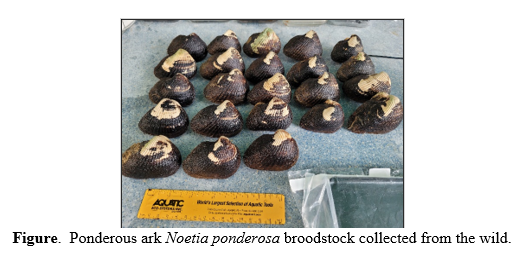SUBSTRATE PREFERENCE FOR SETTLEMENT OF PONDEROUS ARK Noetia ponderosa LARVAE
Previous research on ponderous ark Noetia ponderosa culture indicated a bottleneck at metamorphosis using traditional hard clam Mercenaria culture techniques. Earlier research found no survival using downweller systems, but settlement and surivavl did occur on the macroalgae Ulva and on tank bottoms with or without added natural silt or a benthic diatom assemblage including Amphora. Ponderous ark larvae produce a byssus sheet for attachment similar to byssal threads of blue mussels. Therefore, this project evaluated in a commercial setting the settlement preference for ponderous ark larvae on natural rope, synthetic rope, sand substrate, or no substrate.
Ponderous ark, Noetia ponderosa, broodstock (Fig.) were collected from the wild and conditioned. Spawning occurred volitionally as well as induced by thermal shock. Larvae were cultured using standard hard clam culture techniques. Determination of larval competency is difficult, therefore when larvae reached ~140-200 μm shell length they were transferred to experimental setting systems. Microalgae was added daily along with partial water exchanges during the following 3-4 weeks. After this period, settled larvae were enumerated.
The initial trial found that substrate (nylon rope and sand) containing tanks (n=3) had an average of 9219 (±4515, s.d.) settled larvae, whereas the control tank (n=1) with no substrate had 5280 settled larvae. A second trial will be presented in which replicate (n=3) tanks containing all substrates, as well as an area with no added substrate, were utilized. This project will contribute to developing a setting protocol for ponderous ark, which will assist shellfish hatchery operators who may consider producing ponderous ark seed. This project was supported by a Gulf States Marine Fisheries Commission award (ACQ‐210‐039‐2020‐TAMU).
